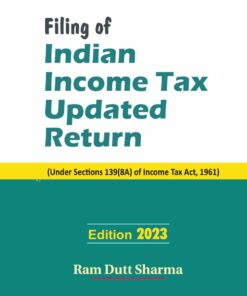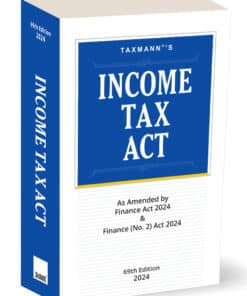- Binding : Paperback
- Publisher : Taxmann
- Author : Pranav Jain
- Edition : 4th Edition 2025
- Language : English
- ISBN-10 : 9789364556675
- ISBN-13 : 9789364556675
Taxmann’s Audit of Financial Statements by Pranav Jain
₹2,395.00 Original price was: ₹2,395.00.₹1,796.00Current price is: ₹1,796.00.
Taxmann’s Audit of Financial Statements by Pranav Jain – 4th Edition 2025. This book is an all-inclusive, practice-driven guide that streamlines the entire audit cycle for financial statements in India, from appointment to final reporting. It prioritises a risk-based approach aligned with Standards on Auditing, tackling developments such as CARO 2020, the updated Audit Quality Maturity Model (AQMM v2), and audit trail regulations. Enriched with practical illustrations, checklists, and regulatory insights, the book thoroughly equips practitioners, audit teams, and finance professionals to meet elevated NFRA, QRB, and SEBI scrutiny. Authored by CA. Pranav Jain, it integrates legal requirements, professional standards, and best practices into a cohesive resource for elevating audit quality.
10 in stock
Taxmann’s Audit of Financial Statements by Pranav Jain – 4th Edition 2025.
Taxmann’s Audit of Financial Statements by Pranav Jain – 4th Edition 2025.
Description
Audit of Financial Statements is a comprehensive and practice-oriented guide that simplifies the entire audit process for financial statements in India. This book addresses the heightened need for robust, risk-based auditing amidst increasing scrutiny by regulators like NFRA, QRB, and SEBI. It walks readers through the entire audit cycle, from appointment and engagement acceptance to final reporting, covering every key concept, procedure, and regulatory requirement in an easy-to-understand, example-driven manner. As the name suggests, the text prioritises the ‘Risk Based Audit’ approach in line with mandatory Standards on Auditing (SAs). It systematically explains each financial statement area’s risk assessment process, potential misstatements, and relevant procedures. The book also incorporates the latest developments, such as enhanced CARO 2020 reporting requirements, the Audit Quality Maturity Model (AQMM) v2, and updated regulations on audit trail and transparency reporting.
This book is intended for the following audience:
- Practitioners & Chartered Accountants – Especially those engaged in statutory audits of corporate and non-corporate entities, looking to update themselves with the latest regulatory changes and best practices
- Audit Firms & Audit Teams – Perfect for audit staff and team leaders who need a practical, step-by-step guide to conduct high-quality audits consistently
- Accounting & Finance Professionals – CFOs, Controllers, and finance managers who interact with auditors or oversee financial reporting
- Students & Academics – CA students, aspirants of professional courses in accounting and auditing, and faculty members who need a thorough, practical reference that aligns with the most recent standards and regulatory guidelines
The Present Publication is the 4th Edition | 2025 and has been amended until 15th March 2025. It is authored by CA. Pranav Jain with the following noteworthy features:
- [Risk Based Audit] Provides a step-by-step methodology for conducting audits in line with mandatory Standards on Auditing, including risk identification, assessment, and mitigation strategies
- [Extensive Practical Illustrations] Complex audit procedures and concepts are simplified using practical examples and numerical illustrations (e.g., reconciliation of payable balances, calculation of FIFO/Weighted Average for inventory)
- [Regulatory Links] Direct references to and reproductions of crucial provisions from Companies Act 2013, ICAI publications, AS/Ind AS, along with relevant extracts to illustrate legal requirements and best practices
- [Enhanced Reporting Requirements] Elaborates on new and evolving disclosures as per Schedule III (Division I), along with commentary on CARO 2020, audit trail reporting, and investor-focused disclosures
- [Audit Documentation & Checklists] Features user-friendly templates and comprehensive checklists (for each major financial statement area, consolidated financials, etc.) to ensure compliance and robust audit files
- [Regulatory Insights] Summaries of significant audit deficiencies noted by NFRA and QRB, along with measures to address them; discussion on the upcoming SQC1 replacement (SQM 1 and SQM 2) and proposed changes to SA 299, SA 600, etc.
- [Illustrative Audit Reports] Presents sample reports, including modified opinions, consolidated financial statements, trust audits, CARO 2020 disclosures, and reporting on the audit trail
- [Focus on Quality & Professional Skepticism] Offers guidance on quality control at the firm and engagement levels, bridging the gap between stakeholder expectations and the auditor’s role
- [Purpose & Vision]
- To provide auditors with a single, in-depth resource that harmonises the legal requirements, professional standards, and best practices into one cohesive handbook
- To elevate audit quality by bridging theoretical knowledge with practical implementation, thereby meeting the evolving expectations of stakeholders and society
The coverage of the book is as follows:
- Complete Audit Lifecycle
- Covers initial acceptance of an audit engagement, risk assessment, internal control evaluation, materiality determination, audit procedures, and issuance of the final audit report
- Company & Non-Corporate Audits
- While primarily focusing on accounting standards (other than Ind AS), it remains highly relevant for Ind AS audits. Procedures for trust, LLP, and other non-corporate entity audits are also addressed
- Regulatory Environment
- Details developments from key regulators (NFRA, SEBI, QRB), including recent Audit Quality Reviews, inspection processes, and the implications for CA firms
- Financial Statement Areas
- Each balance sheet and P&L head is covered extensively (share capital, borrowings, PPE, intangible assets, inventories, revenue, etc.), with relevant disclosures and reporting requirements under the Companies Act 2013
- Hot Topics
- Audit Trail – Importance, compliance requirements, and the newly introduced reporting obligations
- AQMM (v2) – Explains the maturity model, its objectives, and how it measures audit quality
- Joint Audits & Consolidations – Specific guidance for multi-auditor environments, consolidated financial statements, and coordinating with other auditors or component teams
The structure of the book is as follows:
- Foundational Chapters – Lays the conceptual groundwork, including an introduction to the purpose and scope of audits, along with preliminary steps such as appointment, rotation, and removal of auditors
- Risk & Planning – Discusses risk assessment, fraud risks, internal control systems, materiality, and engagement team discussions
- Detailed Audit Procedures – Organised by specific financial statement items, covering the approach, relevant laws, practical work steps, and disclosures for each area
- Completion & Reporting – Discusses final analytical reviews, written representations, forming an audit opinion, drafting the audit report, and key regulatory filings (including CARO 2020)
- Regulatory Framework & Quality – Concludes with an overview of the regulatory mechanism in India, insights on quality control standards, NFRA and QRB reviews, and best practices for continuous audit quality improvement
- Annexures & Checklists – Multiple appendices include ready-to-use templates for engagement letters, confirmations, checklists for each area of the financial statements, sample disclosures, and illustrative audit reports
- Each chapter is designed with a consistent structure—defining the topic, its underlying regulations, potential risks of misstatement, illustrative procedures, and relevant guidance from ICAI and other regulatory bodies.
Details
| Publisher | |
|---|---|
| Author | |
| Language |
Be the first to review “Taxmann’s Audit of Financial Statements by Pranav Jain” Cancel reply
Related products
GST
Bharat’s How to handle GST Audit with real life case studies by CA. Arun Chhajer – 1st Edition 2023
Income Tax
Commercial’s Filing of Indian Income Tax Updated Return by Ram Dutt Sharma – Edition 2023













Reviews
There are no reviews yet.